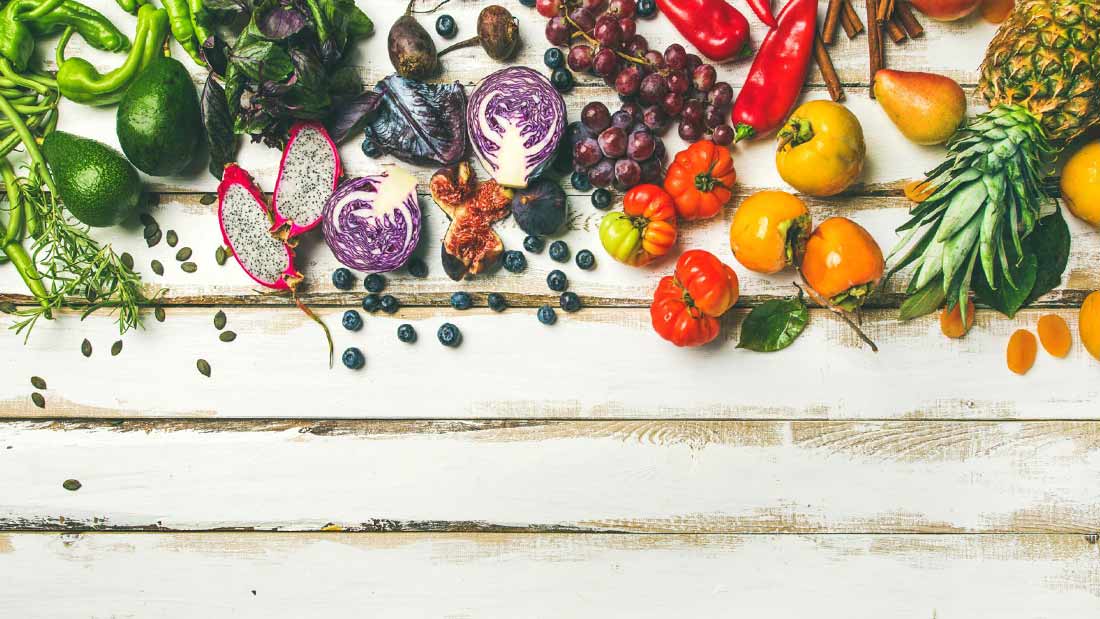PROS AND CONS OF THE RAW FOOD DIET

Some thrive on it and wouldn’t look back while others find it challenging. So what are the advantages and disadvantages of eating raw?
What is the raw food diet?
The raw food diet consists of raw foods or foods that have not been heated over 40°C. It is because higher temperatures destroy some enzymes, vitamins and other nutrients in food. In practice, it means you eat fresh fruit and vegetables, unsweetened dried fruit, raw nuts and seeds, soaked and sprouted grains and pulses, products made from these made by dehydration such as flaxseed crackers, seaweeds, mushrooms, cold-pressed oils and raw chocolate. Processing is allowed if it doesn’t heat the foods, so for example smoothies, cold soups, purées or dips are common.
Is the raw food diet safe – is there anyone it would be unsuitable for?
If you plan your raw diet well, it is safe and can cover your nutritional needs. However, we are all different and some people’s digestive systems seem unable to cope with just raw food, producing lasting digestive troubles. On the other hand, many people thrive on a raw food diet.
If you want to try it, give your body time to adapt. Increase the amount of raw food gradually and pay attention to what works for you. Some food combinations might make your tummy uncomfortable and bloated – take a note and next time don’t combine those foods.
Another point to make is that when you eat only raw foods, you need to eat a bigger volume of food to fulfil your nutritional needs. That’s also why it’s a good idea to blend some foods because it shrinks the volume and helps your body digest the food.
As a raw foodist, you need to take a vitamin B12 supplement and vitamin D in winter – this is not a purely raw food issue, all of us should be taking these.
People with increased energy needs, such as children, pregnant women or athletes may have a problem consuming enough calories because raw plant foods contain a lot of fibre and you may feel full before you’ve eaten enough. For the same reason, raw food diet would be unsuitable for anyone with an eating disorder. People with inflammatory bowel diseases, such as IBS, Crohn’s or ulcerative colitis would very likely experience worsening of their symptoms on purely raw foods.
Lastly, a raw food diet may increase the risk of tooth decay because of all the natural acids and sugars in fruit that is consumed in high amounts. Simply rinsing your mouth with water after you’ve eaten can reduce this risk.
What are the raw food diet health benefits?
You certainly get a lot of antioxidants, vitamins, minerals, healthy carbohydrates, fibre, protein and good fats on a raw food diet. If you plan your diet well and consume enough calories, it can help prevent or even support treatment of some health conditions, such as high blood pressure, heart disease, arthritis, type 2 diabetes, some inflammatory lung conditions and obesity. For many, all the good carbohydrates and fibre help to tune up their digestive system.
Some of the supposed health benefits, such as increased antioxidant intake do not entirely stand up to scrutiny. It is true that cooking destroys some nutrients, such as vitamin C, yet at the same time it increases the bioavailability of others, such as the antioxidant lycopene, beta-carotene or some minerals (iron, calcium or zinc).
Foods to avoid on the raw food diet
While sprouting is allowed and encouraged, when it comes to pulses, only ever sprout lentils and mung beans. Larger beans, such as kidney or butter beans can be toxic because sprouting never gets rid of all their lectins – compounds that can make you very unwell.
Also, never eat raw potatoes, aubergines, green beans or soya beans – we simply cannot digest these raw and they can even cause poisoning.
Want to try the raw food diet?
If you want to give it a go, be prepared to shop more often as you’ll get through a lot of fresh fruit and veggies! Stock up on big packs of raw nuts and seeds and some raw energy bars may also be a good idea – or you can make your own energy balls! It may be useful to try a nutrition tracking app in the beginning so you know that you’re eating enough or if you need to up your intake.
Try some raw favourites from our Vegan Recipe Club: Guacamole, Raw Lasagne or Raw pesto with courgette noodles




